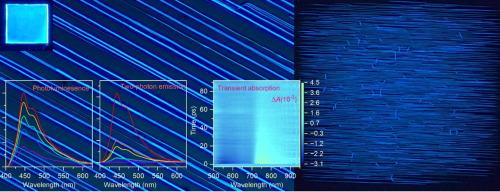当前位置:
X-MOL 学术
›
Chem. Eng. J.
›
论文详情
Our official English website, www.x-mol.net, welcomes your
feedback! (Note: you will need to create a separate account there.)
Addressable planar arrays of highly-luminescent 1,4-bis(5-phenyloxazol-2-yl)benzene nanowires via mask-confined graphoepitaxy for optoelectronic applications
Chemical Engineering Journal ( IF 13.3 ) Pub Date : 2024-11-19 , DOI: 10.1016/j.cej.2024.157759 Wei Zhou, Wanglong Mao, Pingyang Huang, Xiong Huang, Haoyuan Xu, Bo Wu, Xiaofang Jiang, Xiangtao Chen, Hanyu Liu, Guofu Zhou, Jinyou Xu
Chemical Engineering Journal ( IF 13.3 ) Pub Date : 2024-11-19 , DOI: 10.1016/j.cej.2024.157759 Wei Zhou, Wanglong Mao, Pingyang Huang, Xiong Huang, Haoyuan Xu, Bo Wu, Xiaofang Jiang, Xiangtao Chen, Hanyu Liu, Guofu Zhou, Jinyou Xu

|
This study introduces a facile method for the controlled growth of addressable planar arrays of highly luminescent, catalyst-free 1,4-bis(5-phenyloxazol-2-yl)benzene (POPOP) nanowires. By employing a hollow mask over a faceted sapphire substrate, simultaneous control over the position and orientation of the nanowires is achieved through a mask-confined graphoepitaxial growth, offering substantial advantages over traditional post-growth assembly techniques. High-temperature annealing creates parallel nanogrooves on the sapphire surface, inducing a graphoepitaxial effect that aligns the nanowires with a consistent [102] crystallographic axis. The hollow mask further aids in precisely localizing nanowire growth through its shadowing effect. Optoelectronic investigations reveal that these nanowires emit intense and stable blue photoluminescence at room temperature, with a broad spectrum spanning from 400 to 600 nm. This luminescence is achieved through excitation by continuous-wave ultraviolet light or two-photon absorption using femtosecond infrared light. Notably, the emission quantum efficiency of POPOP nanowires reaches 59 %, a remarkable improvement over the 12 % observed in powder counterparts when excited with 405 nm light. Transit absorption spectra indicate that ground state bleaching and excited state absorption display consistent kinetics within a 100 ps time window, suggesting the same origin from singlet excitons. The precise alignment and positioning of these nanowires make them viable for in-situ integration into photodetectors with rapid ultraviolet light responses. This study advances the controlled growth of catalyst-free nanowire arrays and enhances the understanding of the optoelectronic properties of POPOP nanowires.
中文翻译:

通过掩模限制图形外延技术实现高发光 1,4-双(5-苯氧唑-2-基)苯纳米线的可寻址平面阵列,用于光电应用
本研究介绍了一种简单的方法,用于控制高发光、无催化剂的 1,4-双(5-苯氧唑-2-基)苯 (POPOP) 纳米线的可寻址平面阵列的生长。通过在多面蓝宝石衬底上采用空心掩模,通过掩模限制的图形上延生长实现了对纳米线位置和方向的同步控制,与传统的生长后组装技术相比具有显着优势。高温退火在蓝宝石表面产生平行的纳米槽,从而产生石墨上轴效应,使纳米线与一致的 [102] 晶体轴对齐。空心掩模通过其阴影效果进一步帮助精确定位纳米线生长。光电研究表明,这些纳米线在室温下发出强烈而稳定的蓝色光致发光,光谱范围从 400 到 600 nm。这种发光是通过连续波紫外线激发或使用飞秒红外光的双光子吸收来实现的。值得注意的是,POPOP 纳米线的发射量子效率达到 59%,比用 405 nm 光激发时在粉末对应物中观察到的 12% 有了显着提高。凌日吸收光谱表明,基态漂白和激发态吸收在 100 ps 的时间窗口内显示出一致的动力学,表明单线态激子的来源相同。这些纳米线的精确对准和定位使其能够原位集成到具有快速紫外线响应的光电探测器中。这项研究推进了无催化剂纳米线阵列的受控生长,并增强了对 POPOP 纳米线的光电特性的理解。
更新日期:2024-11-19
中文翻译:

通过掩模限制图形外延技术实现高发光 1,4-双(5-苯氧唑-2-基)苯纳米线的可寻址平面阵列,用于光电应用
本研究介绍了一种简单的方法,用于控制高发光、无催化剂的 1,4-双(5-苯氧唑-2-基)苯 (POPOP) 纳米线的可寻址平面阵列的生长。通过在多面蓝宝石衬底上采用空心掩模,通过掩模限制的图形上延生长实现了对纳米线位置和方向的同步控制,与传统的生长后组装技术相比具有显着优势。高温退火在蓝宝石表面产生平行的纳米槽,从而产生石墨上轴效应,使纳米线与一致的 [102] 晶体轴对齐。空心掩模通过其阴影效果进一步帮助精确定位纳米线生长。光电研究表明,这些纳米线在室温下发出强烈而稳定的蓝色光致发光,光谱范围从 400 到 600 nm。这种发光是通过连续波紫外线激发或使用飞秒红外光的双光子吸收来实现的。值得注意的是,POPOP 纳米线的发射量子效率达到 59%,比用 405 nm 光激发时在粉末对应物中观察到的 12% 有了显着提高。凌日吸收光谱表明,基态漂白和激发态吸收在 100 ps 的时间窗口内显示出一致的动力学,表明单线态激子的来源相同。这些纳米线的精确对准和定位使其能够原位集成到具有快速紫外线响应的光电探测器中。这项研究推进了无催化剂纳米线阵列的受控生长,并增强了对 POPOP 纳米线的光电特性的理解。


















































 京公网安备 11010802027423号
京公网安备 11010802027423号